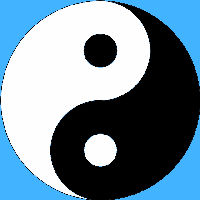An Introduction to Tai Chi as a Martial Art.
Tai Chi for most people, certainly in the West represents a flowing, beautiful, relaxing movement art form and this is true.
It is also however, one of the ultimate martial arts and any contact with high level teachers will make this clear very quickly.
Chen Tai Chi displays the martial applications very clearly. As well as the slow energy collecting movements, there are also fast releases of internal energy, Fah Jing. The dramatic explosive releases of power require the practitioner to be totally relaxed in their body and to have conscious control of their internal energy.
Energy moves down from the dan tian to one of the feet, then back up to the body to the waist, and out by the hand, elbow, shoulder or other foot whichever is transferring the power.
Yang and its derivative forms of Tai Chi may appear not to be martial, but this isn't true, it's simply that they evolved to work in a soft way externally, and powerful way internally. The original Yang forms created by Yang Lu Chan also contained Fah Jing and this is practiced in the Yang Tai Chi of Malaysia.
Yang Chen Fu also practised Fah Jing hand and foot movements most of his life and only later on softened them, so that the energy release is practiced subtely rather than physically. For the highest level of practitioner it will still be there.
Fah Jing can be transmitted in multiple ways by the fist, back of the fist, blade of the hand, end of the fingers, back of the fingers and ultimately with ever other part of the body: elbows, shoulders, hips, knees, feet etc.
There appear to be three basic forms of Fah Jing in Taichi :
The first and most commonly seen being the Chen Fah Jing which commits the body completely to a single punch or kick. The fist is drawn back and released like a rubber band with the other hand moving in the opposite direction allowing one to also strike behind with the elbow. The result if good contact is made is probably serious internal damage for the opponent. The weakness here is that the practitioner commits so fully that if the conflict is not over or another opponent appears quickly then it may be difficult to recover in time. This type is also in Yang Style Taichi but in the form it is practised gently.
The second Fah Jing, perhaps Yang Lu Chan's answer to the weakness of the original Chen Fah Jing, is to create a less committed punch which strikes without so much coiling up of the body. It will still be carried out with the whole of the body, but more from the yinyang energy stored in an external joint rather than the abdominal dantian. This type of punch is much quicker, and can be delivered multiple times causing high levels of pain and external damage but not necessarily death threatening internal damage. The practitioner retains their balance and is able to respond to whatever follows.
The third Fah Jing is present in all taichi but is much more difficult to use as a martial act as it requires the body to be very 'sung' and have strong energy sinking ability. This type does not involve any withdrawal of the fist or other part of the body, rather the Qi is sunk deeply into the ground and all of the muscles of the body are coordinated to transmit a wave of Qi directly to the strike front, so that it releases a powerful hammer action from 'nowhere'. I experienced this punch from a Yiquan master and don't want to feel it again. Feeling is understanding; high level practitioners will be able to cause life threatening damage with any part of their body and this takes the martial arts to their ultimate level.
Tai Chi also contains the full range of wrestling skills, locks, grasps, throws etc. derived from Kung Fu.
The older martial Yang Tai Chi contained aspects of the martial use of acupuncture points, blocking the Qi of the opponent - all very dangerous.
All taichi contains 'Peng, Nu, Ji, An' allowing one to use the other persons energy against them to knock them off balance. Chen Taichi then usually follows with Fah Jing to finish things. Yang Tai Chi includes gentler options and has developed this Aikido like style further with more sensitivity to the weaknesses in the opponents balance, allowing one to guide the person in a given direction or to the ground without causing serious harm i.e. it is more useful for self-defense.
Ultimately all of this becomes irrelevant, as the body becomes more and more 'sung' and the sinking, neutralising skill becomes stronger. At this stage external Qi of whatever form can be harnassed to make the practitioner stronger rather than cause issue and so conflict will be unnecessary or improbable. Technique also becomes unnecessary as the body itself knows how to respond like water to whatever comes into its way.
So all in all Tai Chi is most definitely a martial art for those who wish to develop this aspect, but to achieve any kind of proficiency requires years of practice.
It is important to understand as well that internal power comes from years and year of training and cultivation of ones Qi along with the development of a high capacity for 'fang sung'.
The direct pursuit of 'martial skills' in Tai Chi, might not be the right path, there are techniques to strongly develop the abdominal dantian but a softer journey following the 'natural way' of the Dao might take one much further in the long term.
